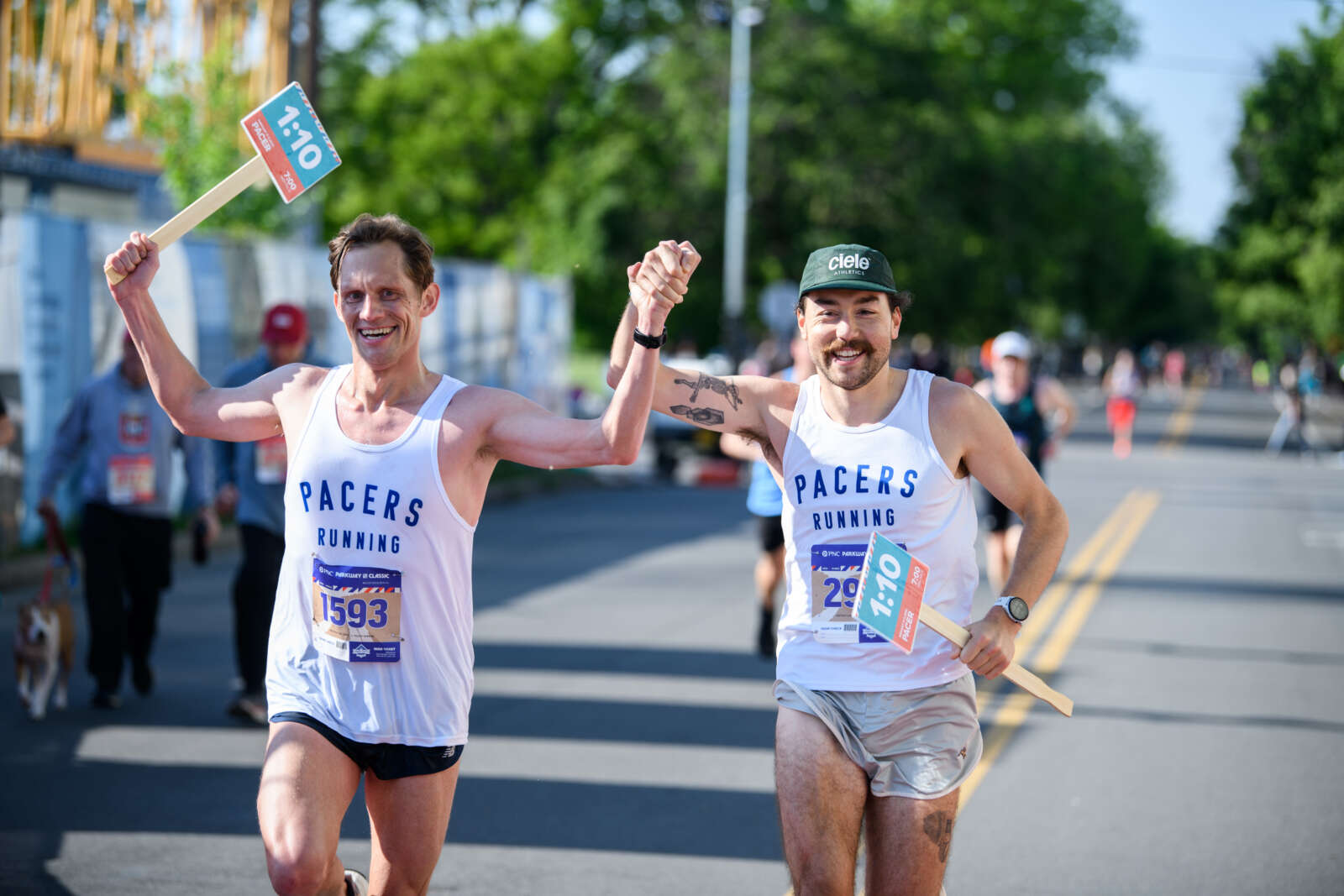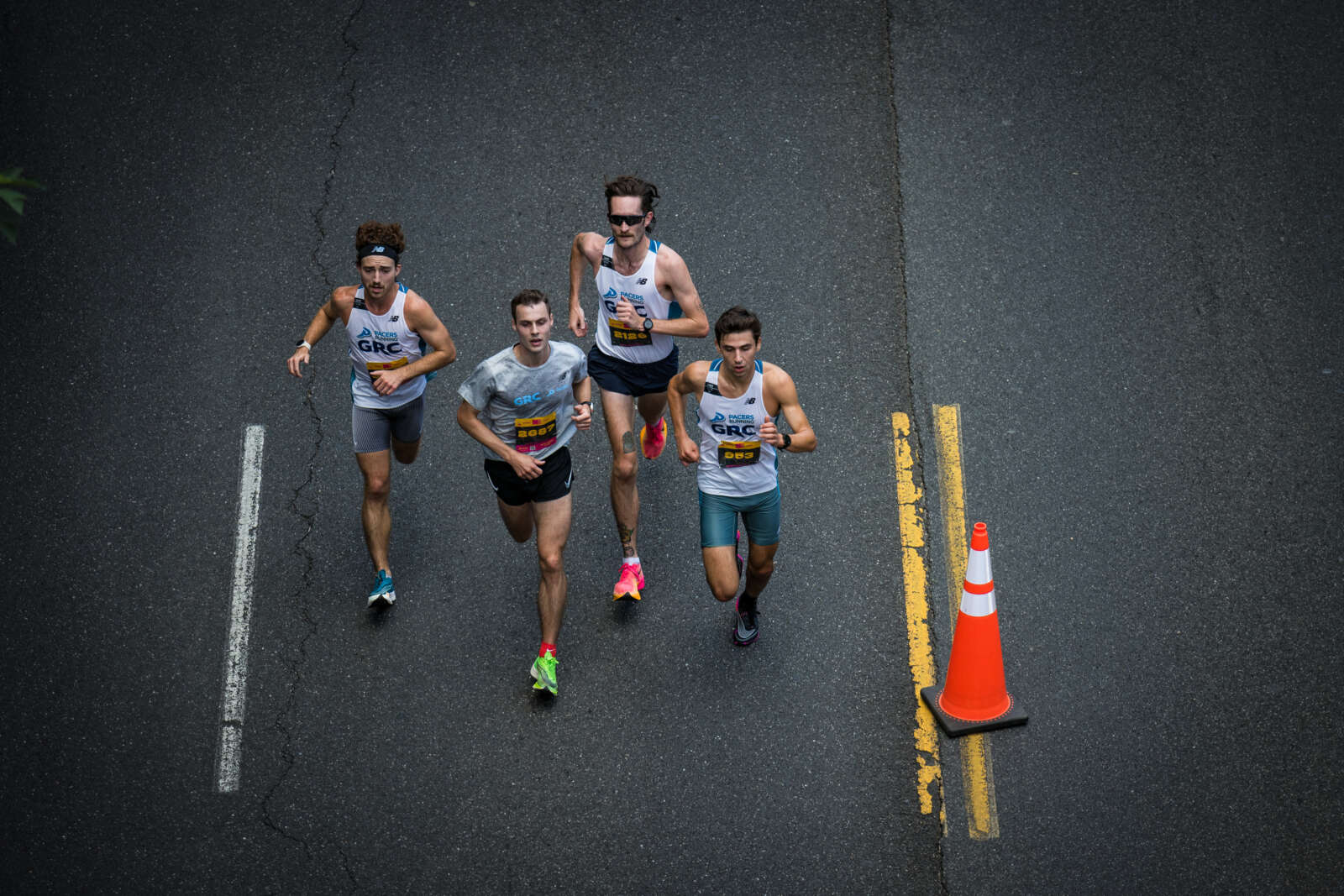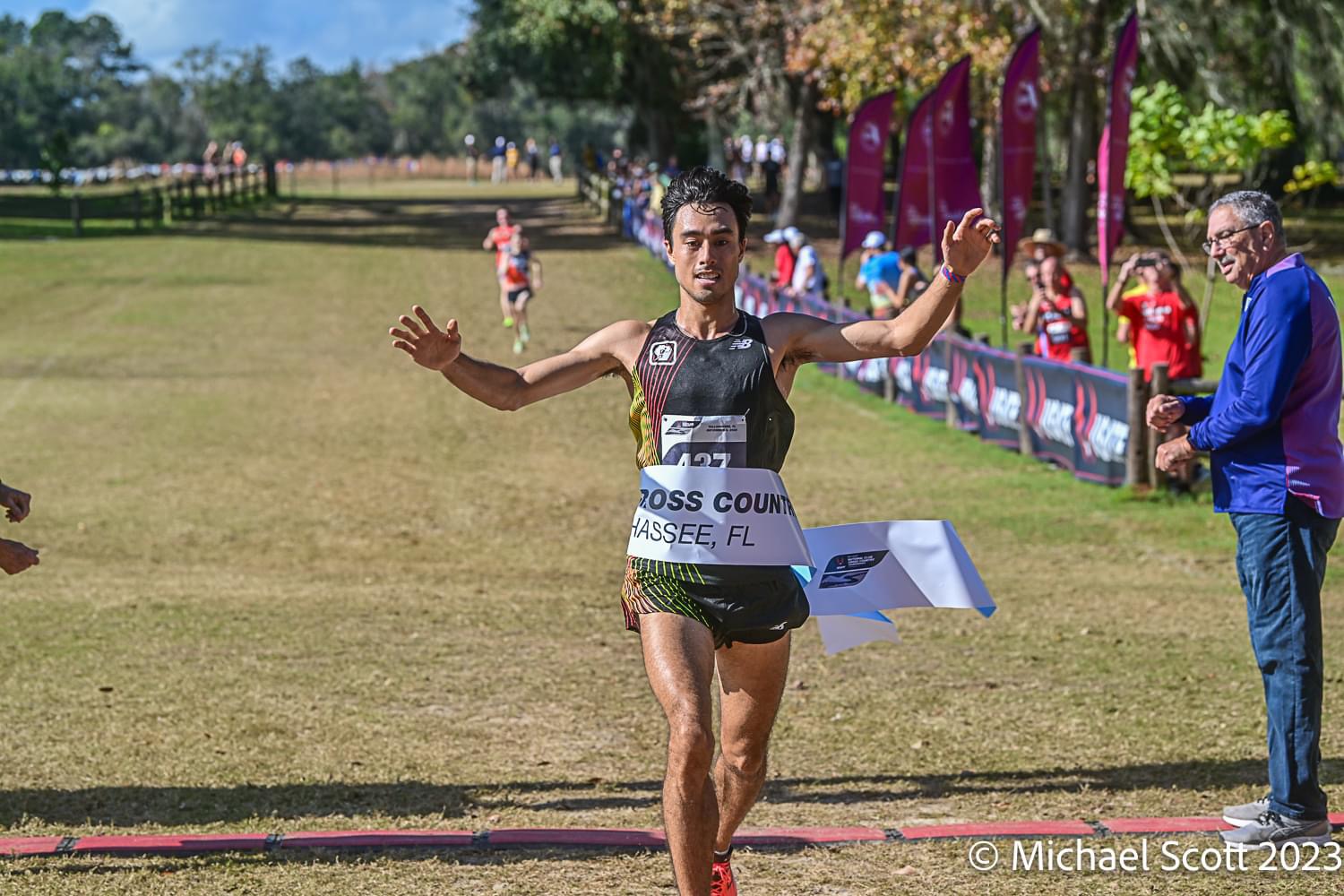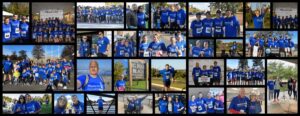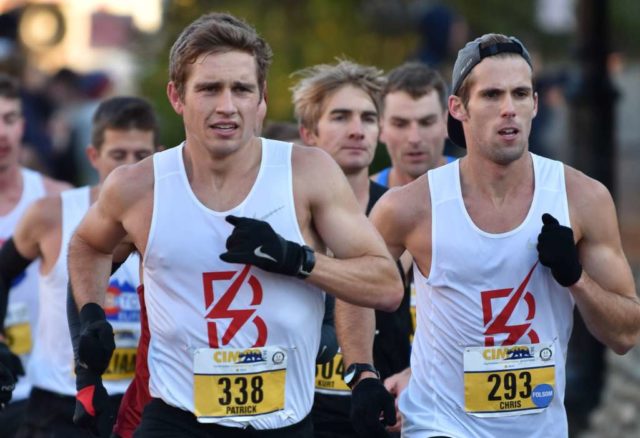
Less than a week ago, Patrick Reaves was on the starting line – and on the list of “Olympic hopefuls” – for an eight-mile race in Atlanta. This was a special event held to preview the course for the U.S. Olympic Marathon Trials, now less than a year away.
Reaves’s result will tell you that he ran 42:14, 5:09 pace, to finish 33rd, and that he lives in Portland, Ore. What it will not tell you is that the 34-year-old runner was actually racing in his hometown, the city where he ran his first marathon as a 19-year-old club runner at the University of Maryland.
Post-race
Reaves sprained his left ankle inthe second mile and ran the rest of the race uncertain of whether it was broken. He finished 140th in 2:30:25.
And while his result indicated — and Reaves himself will confirm it — that a fellow Nike athlete, and three-time national cross country champion, Chris Derrick, tagged along doing a tempo, it will not tell you that Reaves is a professional in the more traditional sense. He’s not paid to run; instead, he’s paid to guide Nike’s social impact strategy, a position that connected him to Bowerman Track Club’s elite corporate team when he and his wife, Valerie, moved to Portland in 2014.
Reaves’s result also will not tell you how he earned the opportunity to be on the starting line: how, in December, at the California International Marathon (CIM), his half marathon split of 1:08:47 was a personal best. He then nearly PRed again, covering the back half only six seconds slower.
This is how Reaves chopped approximately six minutes from his personal best to clock 2:17:40 and beat the sub-2:19 men’s qualifying standard for the trials. Now he’s a year away from competing in the event back in his hometown where his marathon journey began.
Trials Fever
It’s only a little less than a year away from the U.S. Olympic Marathon Trials in Atlanta, but RunWashington already has #trialsfever. This continues a series profiles of the trials qualifiers — see our recent story on Kerry Allen — who live and train locally, or, like in this story, are connected to the D.C. running scene.
To qualify, by Jan. 19, 2020, men must run 2:19:00 or faster in the marathon or 1:04:00 or faster in the half. Women must run 2:45:00 or faster in the marathon or 1:13:00 in the half.
Reaves’s time at CIM was a 12-minute improvement over his personal best when he joined BTC only five years ago. It was also close to a 14-minute improvement since I met Reaves a decade ago at Agricultural History Farm Park in Montgomery County, a week before the USA Cross Country Championships were held there.
I had been hoping to preview the course. As I got out of my car, I looked one way and saw a rolling, rectangular loop in the distance. I then looked back out toward the road and saw a big pack of guys hammering away.
Standing there in the parking lot, I fiddled with my shoelaces as they walked over to their cars, catching their collective breath. They informed me that the course was buried under ice.
New to D.C. without a club to train with, I blurted out to no one particular, “So, who are you guys?” And it was Reaves, a former high school wrestler turned marathoner — one of several future close friends I met that day — who took the time to fill me in.
This was the Georgetown Running Club, a group that had been helping Reaves explore his potential as a runner. After Reaves and others would invite me to join, it would do the same for me, continuing to ground me in the sport a decade later.
* * *
Runners are encouraged to dream and set big goals. But what if, as you began the chase, someone told you: You can do it, but don’t expect it to happen this training cycle or the next. Don’t expect it to happen even this Olympic cycle. What you want to do might take a decade. It might take even longer. And it might be awhile before you even see any improvement.
While it’s easy to say you embrace a long-term approach, I’d bet most of us aren’t necessarily thinking in decade-or-longer timelines. Reaves was. He wasn’t setting moonshot goals; he was making a commitment to group training, consistency, and patience. Instead of looking ahead to the next three months and trying to hit a grand slam, he focused on singles and chipping away.
I just didn’t believe it was possible, until I actually saw Reaves do it, that someone could chip away enough to basically set off an avalanche.
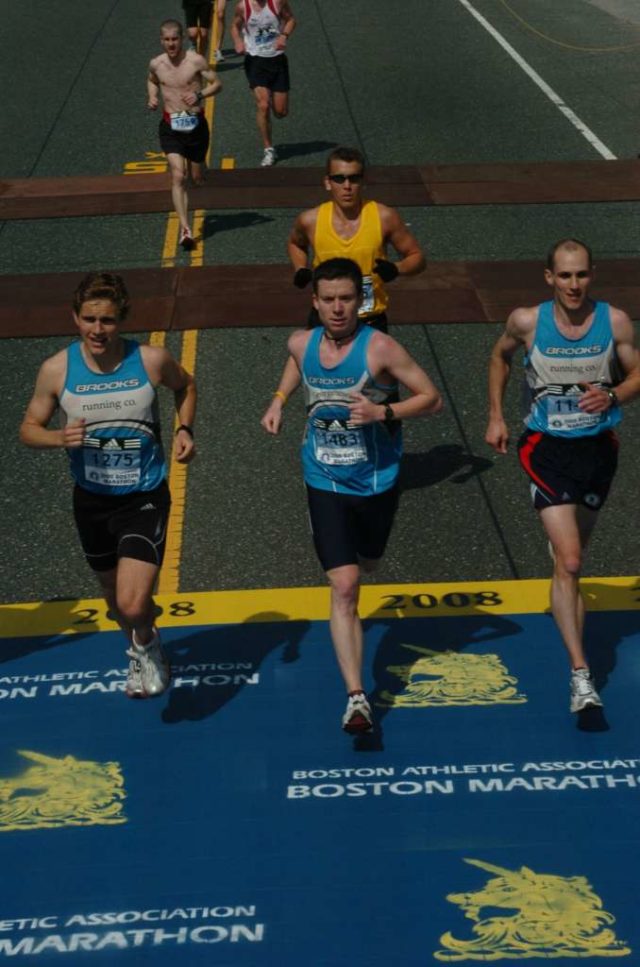
Reaves ran cross country in high school, though mostly to stay fit for wrestling. He committed to running at Maryland, and, as a senior, lowered his marathon PR to 2:42, capping four seasons (two cross country; one indoor and outdoor track apiece) as a walk-on athlete. He then moved to Silver Spring and, with GRC — a new club that didn’t have a women’s team or coach yet — ran 2:31 at the 2008 Boston Marathon. In leading GRC to a fourth place team finish, Reaves ran both the race of his life and the one his father had always wanted to. When Reaves was very young, his father passed away on a run while preparing for his first Boston.
Today, membership in BTC’s corporate team comes with a few more perks than other sub-elite clubs typically offer. Reaves and his teammates have access to many of the same facilities on the Nike campus that the professional athletes use. The bigger perk, though, has been the crew: a group of training partners the likes of Peter Bromka, Chris Yates and Chris Platano who, as they committed to a training system of Reaves’ design, caught the early wave of breakthroughs now happening annually at CIM.
In 2016, Reaves ran a sizeable PR there of 2:25. A year later, he hit 2:23. Then, in April 2018, Reaves found out where the 2020 trials would be held. The chase for a qualifying time, or OTQ, was officially on.
Just found out the Olympic Trials are in my hometown, so I guess I’m going to have to take a shot at 2:19:00. Time to queue up some @Outkast and put the @CocaCola on ice because @btc_elite is about to put in some work between now and @runSRA_CIM https://t.co/zBgADx8ez9
— Patrick Reaves (@RunPR) April 24, 2018
In 2018, Reaves went into his OTQ bid at CIM with 7 teammates trying to run from the mid-2:20s to sub-2:19. The club ended up netting five PRs and got two, including Reaves, under the trials standard.
After you finish this interview with Reaves below — lightly edited for clarity — come back and read Bromka’s essay “Keep on Dreamin.'”
Thinking back to when we first met, was the idea that you could one day qualify for the trials at all in your head?
The trials were in my mind, but the standard seemed so far off that it was always a “maybe someday” kind of goal. t wasn’t until I ran 2:25 in 2016 at CIM that I started taking the idea seriously and realized I could do it. The only real goal has been simple: enjoy the sport and the community, but get better every single year. Literally, just PR, at something, every year.
Fortunately, it’s worked. I think I’ve run some PR in at least one distance every year since college, which I attribute to both training with clubs and staying unusually healthy. I’ve only had one stress fracture, for example, and that was in 2007 and cost me all of four weeks of running. If there’s an analogy, my running has been like a boring, diversified portfolio that grows slowly year over year.
How did you arrive at your overall approach to training? It seems like consistency is what matters most to you.
Consistency definitely matters. I’ve averaged 80 to 85 miles a week since college. Working full-time, I don’t think I’ve been able to sustain more than 110. I had to kind of experiment and find my sweet spot. If I can average 100 miles a week over 10 to 12 weeks before a marathon, that’s typically enough to get me into fighting shape with the workouts.
As for workouts, the plan is just two workouts a week tailored to whatever the goal is at any given period. I also try to stress to the other guys that when you’re trying to run marathons well, 20 miles isn’t a special occasion. That’s just the weekend standard. So I’ll build up to it but find that long, hard workouts are the best preparation for marathon success. That’s not revolutionary or anything, but it works. The big thing is prioritizing those two quality days and making them count. When I write schedules for the BTC training blocks, I just put two workouts in the week and let the guys fill in the rest.
You have a bigger frame for an elite marathoner. At a certain point you could have convinced yourself that you needed to look more like the stereotypical image of a top marathoner.
I started running as a wrestler almost 20 years ago, and to some extent I’m still built like one. But at some point, you just have to accept who you are. I’m never going to have the build of Galen Rupp. After over a decade of averaging over 80 miles a week, you kind of settle into your body. It is what it is, and as long as I’m happy, healthy and still improving year over year, then those are the data points that matter the most to me. A lot of people think I’m a middle distance runner by looking at me, but I’ve never even cracked 4:30 in the mile, which could officially make me have the slowest mile PR on the starting line in Atlanta next year: a badge I’d gladly wear with pride.
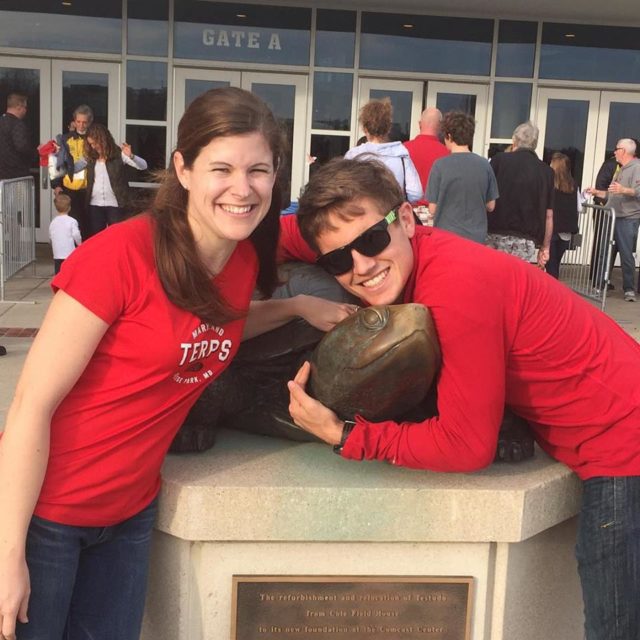
Let’s dial in a little more on marathon training and the Bowerman Club. I think anyone trying to push the boundaries in the marathon should really be paying attention to what you guys are doing – particularly working athletes. What’s the philosophy, and can you share some key workouts?
The training is really grounded in a few principles. First is that you want to touch all of the bases. So you’ll see everything from 400s to 20-mile tempo runs in there, and everything in between. I typically mix in medium-long runs of at least 90 minutes the days after workouts, even the long ones.
The second is the principle of specificity. We run a fair amount of long, hard workouts, because the marathon is a long, hard race. Staples are the 10/10 (10 easy and then 10 at goal marathon pace), a 16-mile tempo at marathon pace, a 20-mile tempo 10-15 seconds per mile slower than marathon pace, and long tempo repeats like 4 times 4-miles. I haven’t reinvented the wheel on much of these, but they work. And when you do the same workouts over and over, they become fairly good indicators of where your fitness is and marathon predictors. In the three years in running CIM, my 16-mile tempos runs were almost exactly the pace I’d end up running at CIM.
It’s a big leap to go from 2:23 to 2:17, but as I watched your training unfold, achieving your goal didn’t feel like a long shot to me.
Going into CIM 2018, I really, really tried to compartmentalize and take care of the little things: cutting out junk and alcohol during the week, making sure I wasn’t skipping weights, taking regular ice baths (having a cold tub at your workplace is a distinct advantage), and running a lot. I averaged 103 miles/week for 10 weeks. Valerie was super supportive and patient because from Labor Day until early December, I wasn’t doing much other than working, running, eating and sleeping.
To your point, I really felt based on the workouts that I had a shot at qualifying. I still had to go through the half marathon mark at CIM in a PR for that distance, and while that was scary in the moment, I knew based on the workouts that I was ready to do it.
Before you head to the trials, you are returning to Boston, where your course PR is 2:28. Are you in the professional start? You must feel like you’re heading into this one as a different athlete.
I’m still not sure what wave I’ll be in for Boston, but I’m hoping I’ll be in the elite field, which would be a first in what will be my sixth Boston. I don’t know how many more opportunities I’ll have to do that, so I’m trying to treat that like the unique experience that it is and just have a good race. I officially have zero expectations or pressure, so I just want to go out there and compete well on a big stage. What I’d actually really like to do is secure a team title for BTC. That’s really the A goal.
You ran your first marathon when you were quite young with the goal of qualifying for Boston. How much of that early goal was fueled by wanting to honor your dad in some way?
When you grow up without a parent, you spend a lot of your life wondering how things would be different. You think about that gap in your life a lot — and it always kind of sucks, if I’m being completely honest. What it would have been like to run with my dad is one of those gaps: something relatively ordinary that we never had the opportunity to do. So, in a way, it was honoring him. But in another way it was the closest thing I could have to a shared experience with him. Anyone who’s run a marathon can relate to one another. That’s what made that first Boston and subsequent Bostons important, too — because I was getting to do something that I know he wanted to do but couldn’t.
It’s such a wild wave of emotions crossing the finish line of any marathon. What was it like to make that final turn at CIM, to see the clock, and know you were going to the trials?
My teammate Jared Carson and I started doing the math with about 5k to go, so I knew I had some cushion. I really tried to savor the last mile and keep moving up in the race all the way through the finish because I really had no idea what place I was in. I saw my friend Peter Birney about a half mile from the finish line, who was absolutely losing his mind, and so at that point I kind of gave it back to him a little bit, realizing I really had done this thing that I thought for a very long time was out of reach.
For me, marathon execution requires managing energy levels and maintaining emotional composure, so when I get close to that finish line when I’m having a good race, it’s hard to keep it all in because it’s honestly a more emotional race than other distances.
Do you have a dream scenario for the trials, and what was the experience like racing the trials course Saturday? What did you think of the course?
After running the test event in March, I know it’s going to be a tough course to run a fast time, so a PR there would be amazing. I want to be able to say I literally gave it my best on the biggest stage in American marathoning. It goes without saying that making the Olympic team will be both incredibly difficult and require a level of marathon fitness that’s 8 to 10 minutes faster than what I’ve run. That’s the hard reality. So, it’s a tall order, but good things can happen when you show up fit and prepared, and you can’t make the team unless you make the Trials. To quote Lloyd Christmas, “So you’re telling me there’s a chance…”
Recent Stories
Looking for our race calendar? Click here Submit races here or shop local for running gear
James W. Foley Freedom Run
Inspired by the moral courage of freelance journalist James Foley, the mission of the nonprofit Foley Foundation is to secure the freedom of Americans held captive abroad unjustly by terrorist organizations or rogue states, and to promote journalist safety.
The
Kensington 8K Race
Since 1994, the Kensington 8K Race has been a favorite DC area fall race – a fun, fast event with beauty, challenge, and excitement. Run it this year on Saturday, September 21, 2024!
The 8K distance is $39, with a


